Copyright 2012 by C.S. Lambert Photographs by photographer: Kevin Atticks, Barbara Austin, Jeff Cotton, Tina Lam, C.S. Lambert, Emily Lilienthal, Benjamin Magro, Dawn Pendleton, Danielle L. Perreault, Robert Hirsch. All rights reserved. ISBN 978-1-60893-178-1 Design by Lynda Chilton Printed in China 5 4 3 2 1 Library of Congress Cataloging-in-Publication Information available on request.
Distributed to the trade by National Book Network 
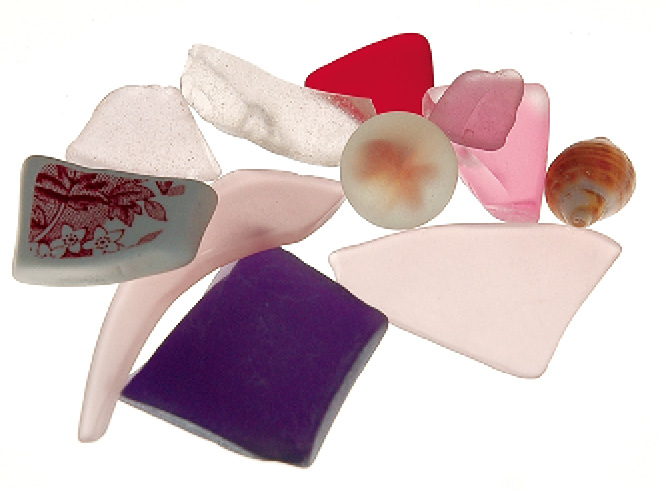 contents Introduction Gulls in a Frame Beach Treasure into Art Treasure Sun Catchers Catch of the Day Mosaic Flower Pot Adorned Shower Curtain Seaside Nightlight Summer Memory Jar Birdbath Sailing in the Air Headband Mermaids Hair Centerpiece Pirates Treasure Scuttled Layered Lamp Holiday Ornament Shadow Box Remembering Uncle Ivor A, B, Sea Alphabet of Found Letters Sea Glass Window The Mermaid and the Pirate Beach in a Box Sea Glass Coffee Table A Beach in the Garden Neptunes Necklace Wreath Not Just for the Holidays Sea-Shard Picture Frame More Than a Thousand Words Barrette Making Waves Kennebunk Candlescape Garden Edging Walking Stick A Quiet Companion Time and Tide Treasure Clock Chandelier Love Lost and Suspended Aquarium Twenty Thousand Leagues Plaster Casts with Sea Glass Lasting Impressions Garden Illuminata Acknowledgments
contents Introduction Gulls in a Frame Beach Treasure into Art Treasure Sun Catchers Catch of the Day Mosaic Flower Pot Adorned Shower Curtain Seaside Nightlight Summer Memory Jar Birdbath Sailing in the Air Headband Mermaids Hair Centerpiece Pirates Treasure Scuttled Layered Lamp Holiday Ornament Shadow Box Remembering Uncle Ivor A, B, Sea Alphabet of Found Letters Sea Glass Window The Mermaid and the Pirate Beach in a Box Sea Glass Coffee Table A Beach in the Garden Neptunes Necklace Wreath Not Just for the Holidays Sea-Shard Picture Frame More Than a Thousand Words Barrette Making Waves Kennebunk Candlescape Garden Edging Walking Stick A Quiet Companion Time and Tide Treasure Clock Chandelier Love Lost and Suspended Aquarium Twenty Thousand Leagues Plaster Casts with Sea Glass Lasting Impressions Garden Illuminata Acknowledgments 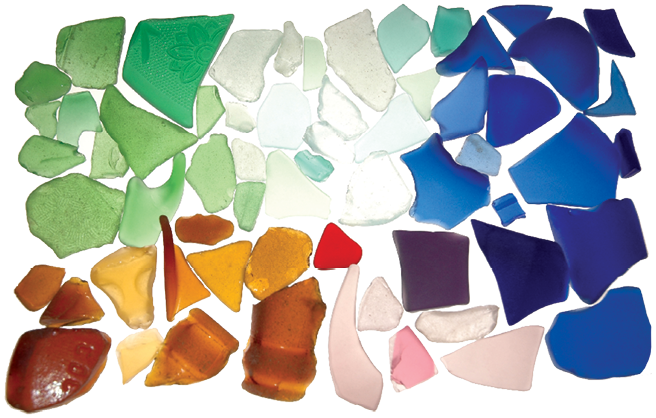 introduction If you love sea glass, you are sure to find ideas in this book that will inspire you to incorporate your seaside treasures into your home dcorinside and out, practical and decorative, whimsical and serious. Here you will find the basic tools and materials youll need to get started, as well as step-by-step instructions and photographs to lead you along the way. Each project can be easily modified or adapted to a different purpose, using the same tools and materials. Many can be made in an hour or less. You might want to embellish your projects with shells, pebbles, driftwood, and other seaside caches. Yard sales, flea markets, thrift stores, craft stores, and even the local dump offer inexpensive additions, or you might be a purist and add nothing but glue to your sea glass project.
introduction If you love sea glass, you are sure to find ideas in this book that will inspire you to incorporate your seaside treasures into your home dcorinside and out, practical and decorative, whimsical and serious. Here you will find the basic tools and materials youll need to get started, as well as step-by-step instructions and photographs to lead you along the way. Each project can be easily modified or adapted to a different purpose, using the same tools and materials. Many can be made in an hour or less. You might want to embellish your projects with shells, pebbles, driftwood, and other seaside caches. Yard sales, flea markets, thrift stores, craft stores, and even the local dump offer inexpensive additions, or you might be a purist and add nothing but glue to your sea glass project.
The idea for this book has been on my mind for a number of years. During my travels, other sea glass aficionados often asked me what I did with my collection. I usually stammered, embarrassed by my lack of crafting talent. Beyond stringing bottlenecks on an old weathered rope hanging in my kitchen window, I really hadnt made anything at all. Like many seaglunkers, I had lined my living room baseboards with Atlas jars filled to the brim with sea glass. A large apothecary chest with drawers organized by glass color and size sat in my front hallway.
Some drawers held shards with words or partial words and numbers; another held pieces with lions and unicorns signifying Englands Royal Warrants. I hunted and gathered, but my right-side brain hadnt opened up to creative direction. I was content to hoard sea glass without giving it a purpose. And, of course, theres nothing wrong with that. Unaltered, individual pieces of sea glass are priceless. 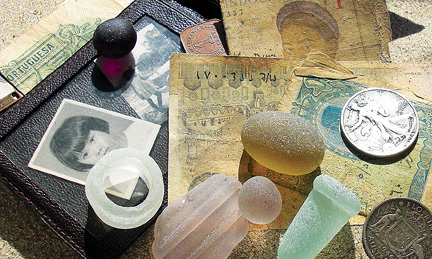 Then my publisher suggested I take something with me to book signingssomething that showed off part of my collection.
Then my publisher suggested I take something with me to book signingssomething that showed off part of my collection.
More panicked than inspired, I found an old shadow box, stuck sandpaper on the inside, and glued some of my favorite pieces of glass and pottery onto the sandpaper. Voil. My first attempt at crafting turned out to be a multi-media masterpiece. Like a cabinet of curiosities, the shadow box reveals one ruby red, several highly coveted cobalts, as well as less favored ambers and emeralds (often mistaken for beer bottle fragments). Shards with faded scrolls and partial scenes inspired by nineteenth century grand tours mix with a rare bisque doll arm and a moss green stopper from an abandoned apothecary bottle. This display draws attention everywhere I take it.
And, sure enough, it has spawned other sea glass shadow boxes around the world. 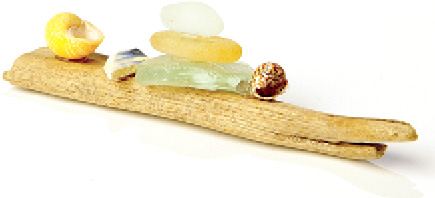 This book shows diverse interpretations of sea glass craft. One piece of sea glass might inspire an entire work of art in the same way that heaps of multi-colored glass or a group of whites might provide a background for another project. As a large-scale project or as a solitary fragment centered in a frame, the crafts in this book invent, embellish, and transform, but all remain true to the nature of sea glass. So the next time you feel overwhelmed or buried under piles of sea glass, flip through these pages, follow or adapt the instructions to create something beautiful, or use the book as a launching pad for your own ideas. Preparation Every time I return from the beach with sea glass and shards in my pockets, I place them in a metal bucket, add a squirt of dish detergent, a half capful of bleach, then fill the bucket three-quarters full with hot water.
This book shows diverse interpretations of sea glass craft. One piece of sea glass might inspire an entire work of art in the same way that heaps of multi-colored glass or a group of whites might provide a background for another project. As a large-scale project or as a solitary fragment centered in a frame, the crafts in this book invent, embellish, and transform, but all remain true to the nature of sea glass. So the next time you feel overwhelmed or buried under piles of sea glass, flip through these pages, follow or adapt the instructions to create something beautiful, or use the book as a launching pad for your own ideas. Preparation Every time I return from the beach with sea glass and shards in my pockets, I place them in a metal bucket, add a squirt of dish detergent, a half capful of bleach, then fill the bucket three-quarters full with hot water.
I stir the contents with a spoon or a stick and let them soak for at least two hours. Afterward I pour the sea glass into a strainer, rinse thoroughly, and spread it out on newspaper to dry. This not only helps rid the glass and shards of bacteria, but also cleans the surface for better adhesion to surfaces when gluing. After the pieces have dried, I separate the colors into individual jars. A Note About Quality Like wine, sea glass needs sufficient time to mature. If the fragments are plucked from the beach too early, they will have sharp edges and a shiny surface.
Traveling with the oceans cyclical rhythms creates a patina, or buffeted surface, and this provenance defines sea glass. Without it, the fragments are just debris. Why Do We Craft? Crafting helps capture and preserve specific moments and emotions. It opens a dialogue between objects and people, and in some cases, articulates what words cannot. According to New York University psychologist Dr. Robert Reiner, The act of performing a craft is incompatible with worry, anger, obsession, and anxiety.
Crafts make you concentrate and focus on the here and now and distract you from everyday pressures and problems. Theyre stress-busters in the same way that meditation, deep breathing, visual imagery, and watching fish are. With the exception of the word obsession, Dr. Reiner might have meant sea glass collecting itself. To the uninitiated, we hunters must look like a group of penguins marching slowly along, heads tucked down, with more deliberation than other beachcombers. By making things with sea glass we are reinventing, embellishing, transforming, and from the environmentalists point of view, cleaning up the beach.
The Craft and Hobby Association points out that eight out of ten American households have one family member who crafts. Whether you knew it or not, you have colleagues in this often-dismissed alternate art world. So here are a few venerable crafters, some with whom you might identify. Martha Stewart is the undisputed leader today, but early crafting bulwarks include the Cro-Magnons with their cave paintings. The Egyptians made their mask of King Tut. Pablo Picasso coined the term collage when it became a distinct segment of modern art, and William Morris founded an entire genre, the Arts and Crafts Movement.
Next page
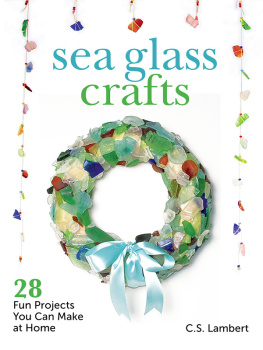
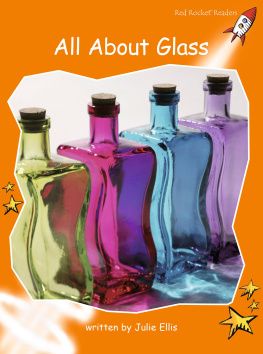
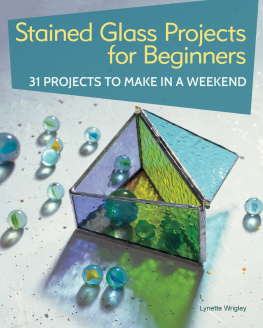
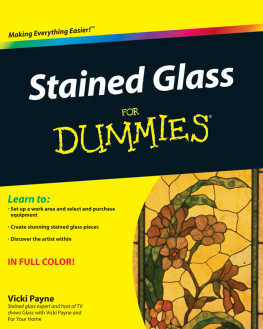
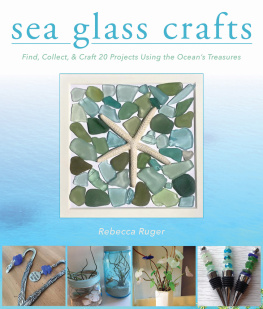
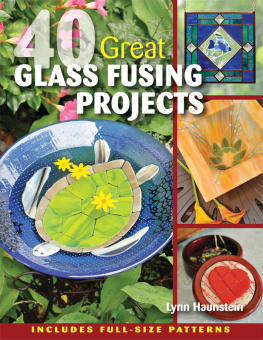
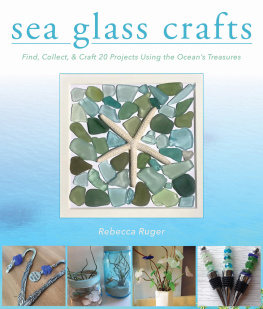


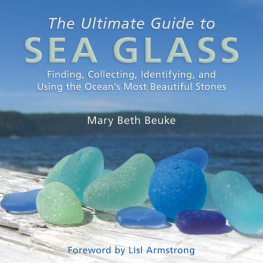

 contents Introduction Gulls in a Frame Beach Treasure into Art Treasure Sun Catchers Catch of the Day Mosaic Flower Pot Adorned Shower Curtain Seaside Nightlight Summer Memory Jar Birdbath Sailing in the Air Headband Mermaids Hair Centerpiece Pirates Treasure Scuttled Layered Lamp Holiday Ornament Shadow Box Remembering Uncle Ivor A, B, Sea Alphabet of Found Letters Sea Glass Window The Mermaid and the Pirate Beach in a Box Sea Glass Coffee Table A Beach in the Garden Neptunes Necklace Wreath Not Just for the Holidays Sea-Shard Picture Frame More Than a Thousand Words Barrette Making Waves Kennebunk Candlescape Garden Edging Walking Stick A Quiet Companion Time and Tide Treasure Clock Chandelier Love Lost and Suspended Aquarium Twenty Thousand Leagues Plaster Casts with Sea Glass Lasting Impressions Garden Illuminata Acknowledgments
contents Introduction Gulls in a Frame Beach Treasure into Art Treasure Sun Catchers Catch of the Day Mosaic Flower Pot Adorned Shower Curtain Seaside Nightlight Summer Memory Jar Birdbath Sailing in the Air Headband Mermaids Hair Centerpiece Pirates Treasure Scuttled Layered Lamp Holiday Ornament Shadow Box Remembering Uncle Ivor A, B, Sea Alphabet of Found Letters Sea Glass Window The Mermaid and the Pirate Beach in a Box Sea Glass Coffee Table A Beach in the Garden Neptunes Necklace Wreath Not Just for the Holidays Sea-Shard Picture Frame More Than a Thousand Words Barrette Making Waves Kennebunk Candlescape Garden Edging Walking Stick A Quiet Companion Time and Tide Treasure Clock Chandelier Love Lost and Suspended Aquarium Twenty Thousand Leagues Plaster Casts with Sea Glass Lasting Impressions Garden Illuminata Acknowledgments  introduction If you love sea glass, you are sure to find ideas in this book that will inspire you to incorporate your seaside treasures into your home dcorinside and out, practical and decorative, whimsical and serious. Here you will find the basic tools and materials youll need to get started, as well as step-by-step instructions and photographs to lead you along the way. Each project can be easily modified or adapted to a different purpose, using the same tools and materials. Many can be made in an hour or less. You might want to embellish your projects with shells, pebbles, driftwood, and other seaside caches. Yard sales, flea markets, thrift stores, craft stores, and even the local dump offer inexpensive additions, or you might be a purist and add nothing but glue to your sea glass project.
introduction If you love sea glass, you are sure to find ideas in this book that will inspire you to incorporate your seaside treasures into your home dcorinside and out, practical and decorative, whimsical and serious. Here you will find the basic tools and materials youll need to get started, as well as step-by-step instructions and photographs to lead you along the way. Each project can be easily modified or adapted to a different purpose, using the same tools and materials. Many can be made in an hour or less. You might want to embellish your projects with shells, pebbles, driftwood, and other seaside caches. Yard sales, flea markets, thrift stores, craft stores, and even the local dump offer inexpensive additions, or you might be a purist and add nothing but glue to your sea glass project. Then my publisher suggested I take something with me to book signingssomething that showed off part of my collection.
Then my publisher suggested I take something with me to book signingssomething that showed off part of my collection. This book shows diverse interpretations of sea glass craft. One piece of sea glass might inspire an entire work of art in the same way that heaps of multi-colored glass or a group of whites might provide a background for another project. As a large-scale project or as a solitary fragment centered in a frame, the crafts in this book invent, embellish, and transform, but all remain true to the nature of sea glass. So the next time you feel overwhelmed or buried under piles of sea glass, flip through these pages, follow or adapt the instructions to create something beautiful, or use the book as a launching pad for your own ideas. Preparation Every time I return from the beach with sea glass and shards in my pockets, I place them in a metal bucket, add a squirt of dish detergent, a half capful of bleach, then fill the bucket three-quarters full with hot water.
This book shows diverse interpretations of sea glass craft. One piece of sea glass might inspire an entire work of art in the same way that heaps of multi-colored glass or a group of whites might provide a background for another project. As a large-scale project or as a solitary fragment centered in a frame, the crafts in this book invent, embellish, and transform, but all remain true to the nature of sea glass. So the next time you feel overwhelmed or buried under piles of sea glass, flip through these pages, follow or adapt the instructions to create something beautiful, or use the book as a launching pad for your own ideas. Preparation Every time I return from the beach with sea glass and shards in my pockets, I place them in a metal bucket, add a squirt of dish detergent, a half capful of bleach, then fill the bucket three-quarters full with hot water.